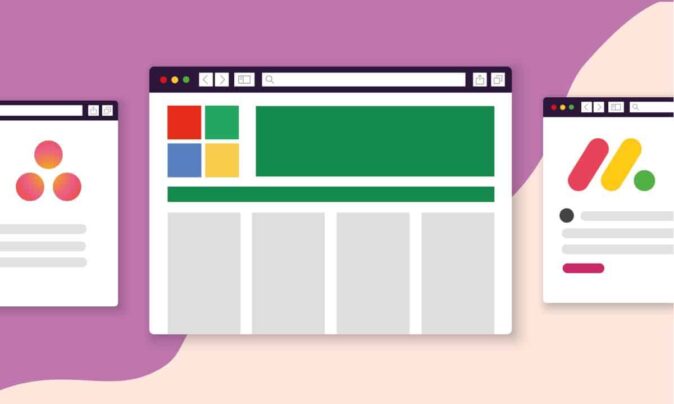In this article, we look at 15 Enterprise Project Management tools. We’ll compare their features, ease of use, and price — the top 3 factors teams look at before choosing a PM tool.
Specifically, we’ll answer:
- What is EPM software?
- Do you need to invest in one?
- What are the features you should look for?
- Which EPM tool is right for you?
- Overview of 15 EPM tools
Let’s begin.
What Is Enterprise Project Management Software?
EPM software helps organizations manage multiple projects. Depending on your role, EPM software helps you:
- Get a 360-degree overview of the organization’s progress.
- Align resources in line with the leadership’s vision.
- Manage a portfolio of projects.
- Plan, track and manage a project’s schedule.
- Communicate, collaborate, and execute a project.
Enterprise project management tools help you automate the above activities using software.
Do You Need Enterprise Project Management Tools?
Project management software is widely used across software, service, manufacturing, and marketing industries.
Yet, according to this survey, around 50 percent of businesses still use manual methods, spreadsheets, or office tools to manage projects.
So, how do you decide if you should invest in an EPM tool?
If you’re not currently using software to manage your projects, there are a few telltale signs that can help you decide.
- Lack of visibility across projects and resources.
- Inconsistent processes across project teams.
- Siloed information and project teams.
- Dropped tasks.
- Ineffective collaboration.
If you see these signs in your organization, it’s time to invest in software.
What Are The Features Of Enterprise Project Management Tools?
While it’s difficult to find a tool that meets all your needs, there are a few common features that you should look for in an EPM tool.
- Project portfolio management
- Project planning
- Task management
- Collaboration
- Time tracking
- Resource management
- Budget management
- Reports
According to Capterra, task management is the most used feature in project tools. However, that does not mean that you can make do with a simple task management app.
Which Enterprise Project Management Tool Is Right For You?
Choosing an EPM tool is a balancing act between your budget, priorities, and features.
Here’s a quick comparison of all the tools in this article. Find a tool that you like in the table below.
| Tool | Price (user/mo) | Features |
|---|---|---|
| Toggl Plan | Free – $15 | Easy to use, visual EPM tool with project scheduling, task management, resource planning, and time tracking features. |
| Microsoft Project | $10 – $55 | A popular tool among trained project managers. Available along with the Microsoft-365 suite. |
| Asana | Request a quote | Project management platform with planning, task management, and workload management features. |
| Trello | Free – $17.50 | Enterprise task management tool with Kanban boards and workflow automation. |
| Clarizen | Request a quote | Comprehensive PM tool with schedule, task, resource, timesheet, and financial management features. |
| Smartsheet | Request a quote | A spreadsheet-like tool with templates for all project activities. |
| ProjectManager | $15 – $25 | Comprehensive EPM tool with Gantt charts, task boards, timesheets, and reports. |
| Planview | Request a quote | Managing portfolios, strategic planning, and work management for enterprise teams. |
| Jira | Request a quote | Software development project tool with project planning, issue management, and enterprise-grade security. |
| Sciforma | Request a quote | Enterprise-centric portfolio and project management software. |
| LiquidPlanner | $45+ | EPM tool with dashboard reports, task management, resource management, and time-tracking features. |
| Huddle | Request a quote | Document collaboration and client management tool with enterprise-level security features. |
| Workzone | $24 – $43 | Enterprise PM tool with planning, task management, time tracking features. |
| Wrike | Request a quote | Versatile project software with project templates and time tracking. |
| Entry | $20 – $28 | Enterprise-grade customer service and project execution software. |
Brief Overview Of Enterprise Project Management Tools
We’ve looked at a quick comparative list of EPM tools. Next, let’s look at a brief overview of each tool.
Toggl Plan
Toggl Plan comes with robust visual planning and task management features. Unlike other tools on this list, Toggl Plan thrives on simplicity without cluttering up the workspace. It’s a tool that your team will actually enjoy using every day.
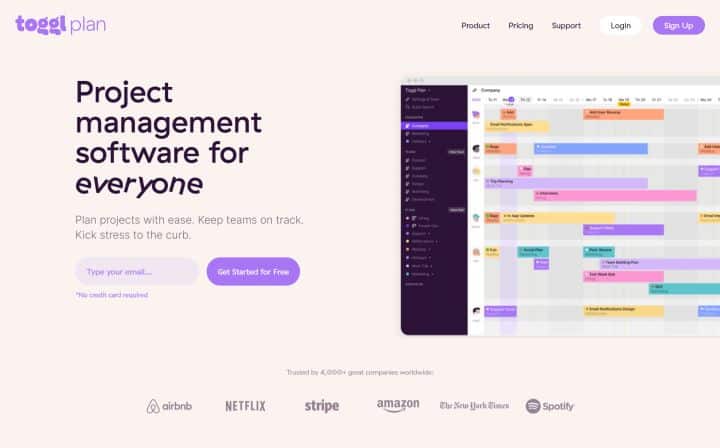
What makes Toggl Plan the right tool for managing enterprise projects?
- Easy to use online tool with almost no learning curve.
- Intuitive drag & drop interface.
- Project timelines to plan project roadmaps and schedules.
- Week, month, quarter, and annual timeline views.
- Team timelines to visually manage shared resources, resource allocation, and manage workloads.
- Kanban boards to visually manage project iterations.
- Read-only shared timeline for clients.
- Personal task-dashboard to stay on top of tasks.
- Ability to plan recurring tasks.
- Integrations for Toggl Track time tracking, calendar apps, and Github.
Where does Toggl Plan fall short?
- Lacks features to manage budgets and project portfolio.
- Doesn’t have reports.
What does Toggl Plan cost?
- Free for solo users with unlimited projects.
- Team plans start at $9 per user per month. Sign up for a free trial to get customization options, multi-assign tasks, recurring tasks, time tracking, and access rights.
I have tried more project management software packages than I care to admit. I finally found one that works. (Toggl Plan has) enough detail to be useful but easy enough to use.
Jendi, CEO
Microsoft Project
Microsoft Project is a popular tool among trained project managers. Today it’s also available as an online PM tool along with the Microsoft 365 suite of products.
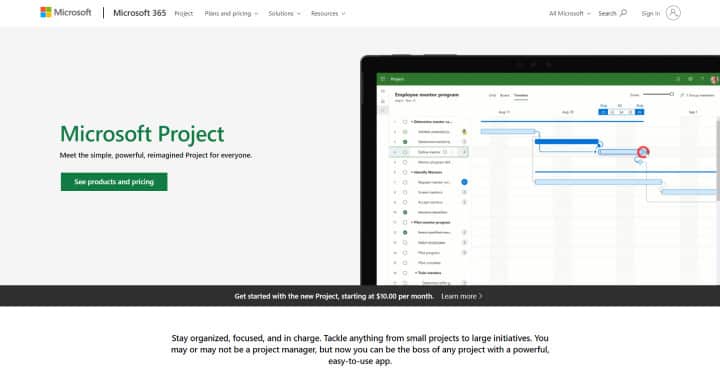
What makes MS Project the right PM tool for enterprise?
- Ideal for technical project managers.
- Track and manage projects using ordered task lists & boards.
- Gantt timelines to plan project schedules.
- Prebuilt reports to track project progress.
- Timesheets and resource management.
- Strategic portfolio planning.
Where does MS Project fall short?
- It can feel overwhelming to non-technical project managers.
- Fairly expensive top plan at $55 per user per month.
Here are some alternatives to MS Project.
What does Microsoft Project cost?
- No free plan or a free trial.
- Paid plans range from $10 – $55 per user per month. Features to manage resources and project portfolios are available only in the top plan.
This is the most powerful and flexible Project Management software out there especially for building a WBS and project schedule. The Gantt and the schedule management capabilities are invaluable for Project Managers.
Mustafa, Senior Project Manager
Asana
Asana is a flexible PM tool with various ways to organize work — from daily tasks to strategic initiatives. It comes with robust features for planning, managing tasks, and balancing workloads.

What makes Asana a popular EPM tool?
- Gantt timelines and calendars to plan work.
- Task lists and boards to track project progress.
- Customizable, automated workflows.
- Built-in approvals and proofing.
- Project portfolios to see the project progress across the organization.
- Goals to set and track strategic initiatives.
Where does Asana fall short?
- With so many ways to use, Asana can feel overwhelming.
- The free plan is fairly limited without the timeline feature.
- Reviewers often complain about Asana’s customer support.
Here are some alternatives to Asana.
What does Asana cost?
- The free plan is suitable for teams with up to 15 members. However, it only has task lists, boards, and a calendar view.
- Paid plans range from $13.50 – $30.49 per user per month. And come with Gantt timelines, portfolio management, approvals, and proofing features.
- The Enterprise plan’s pricing is available on request.
The best part about Asana is how customizable it is in so many different facets, you can really tailor it to the needs of your specific team and project.
Ciera, Impact Coordinator
Trello
It wouldn’t be unfair to say that Trello made board-based task management accessible to everyone. On the surface, Trello appears like a simple task management tool. However, workflow automation, powerups, and security make it an attractive tool for enterprise users.

What makes Trello suitable for enterprise?
- Simple, drag, and drop board-based task management.
- Customizable workflows and custom task fields to adapt to your needs.
- Board templates for recurring projects.
- Integration with popular tools and powerups to add more functionality.
- Workflow automation for everyday tasks.
- Organization-wide access controls.
Where does Trello fall short?
- Lack of planning and resource management features.
- Lack of visibility across boards.
Here are some alternatives to Trello.
What does Trello cost?
- With Trello’s free plan, you can manage up to 10 team projects.
- Paid plans range from $12.50 – $17.50 per user per month. And come with all integrations, unlimited automation, and power-ups.
The ability to see all your tasks allows you to prioritize and organize what to accomplish. Overall runs smoothly with a very clean user interface. It is easy to use and requires little to no training.
Handel, Videographer
Clarizen
If you’re looking for an enterprise-level online work collaboration tool, Clarizen might be for you. Clarizen helps you turn your business ideas into strategies, plans, and actions for your team.

What makes Clarizen suitable for enterprise PM?
- Customizable workflows and configurable UI to adapt to your organization’s way of work.
- Dashboard reports for a clear overview of your enterprise.
- Discussions, emails, files, and links to collaborate across teams.
- Centralized digital proofing and approvals.
- Data-driven resource and financial management.
- Integration features for Jira, Slack, Sharepoint, Tableau, and more.
Where does Clarizen fall short?
- It may feel like overkill for small enterprise teams.
- Lack of clarity in pricing.
What does Clarizen cost?
- Clarizen does not have a free plan or trial.
- Paid plans are available in two flavors — Enterprise and Unlimited. However, you need to contact Clarizen and request a quote.
We are implementing Clarizen for the entire organization. Our goal is to capture all requests and projects in one place for review, approval, management, and reporting.
Sean, Technical Project Manager
Smartsheet
Smartsheet is a secure, scalable platform that helps enterprise teams manage work in an ever-changing world. Using Smartsheet, you can unify collaboration and workflows across your organization.

What makes Smartsheet a solid EPM tool?
- Spreadsheet-like interface.
- Flexible workflow templates for all kinds of projects.
- Calendar, Board, and Gantt chart view to visualize work.
- Real-time dashboard reports staying on top of KPIs.
- Time tracking.
- Portfolio and resource management.
- Integrations with Slack, MS Teams, Dropbox, and more.
Where does Smartsheet fall short?
- Long learning curve.
- Reviewers feel that the UI is outdated and prefer Google Sheets over Smartsheet.
- You have to pay for the entire year.
What does Smartsheet cost?
- Smartsheet has a free 30-day trial.
- Paid plans come in two flavors — Standard and Enterprise. Standard plans range between $168 – $300 per user per year. Enterprise pricing is available on request.
The overall architecture is really promising — having different sheets with the potential to track sign-off and create Dashboards. Seems great for managing large-scale PMO over multiple countries and regions.
Tobias, Program Manager
ProjectManager.com
ProjectManager.com provides online project management, time-tracking, and collaboration tools for project teams. It ensures that your projects are on track with a real-time overview.
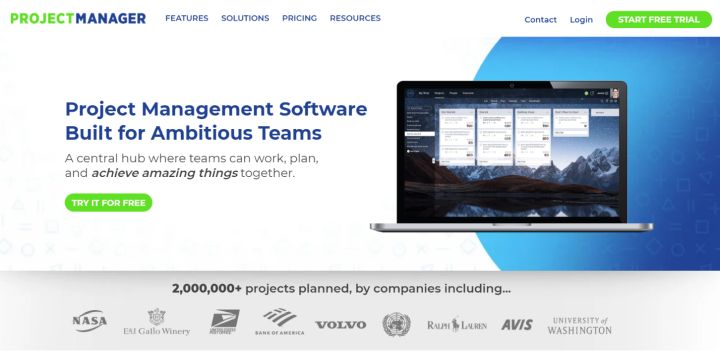
Why choose ProjectManager.com as your enterprise PM tool?
- Gantt chart maker to plan, schedule, and assign work.
- Task lists and Kanban boards to track tasks.
- Project dashboards and reports for a quick overview.
- Timesheet reports to track time and costs.
- Project portfolios to group and organize projects.
Where does ProjectManager.com fall short?
- Reviewers complain about their customer service and sales practices.
- Poor access control.
What does ProjectManager.com cost?
- Free 30-day trial.
- Monthly plans cost $15 – $25 per user per month. Enterprise plan pricing is available on request.
It is fairly easy to use. The reports you can make are good and it definitely helps with managing of projects.
Jenna, Product Developer
Planview
Planview Enterprise comes with project and portfolio management. It integrates projects, solutions, and strategies in a single online tool.
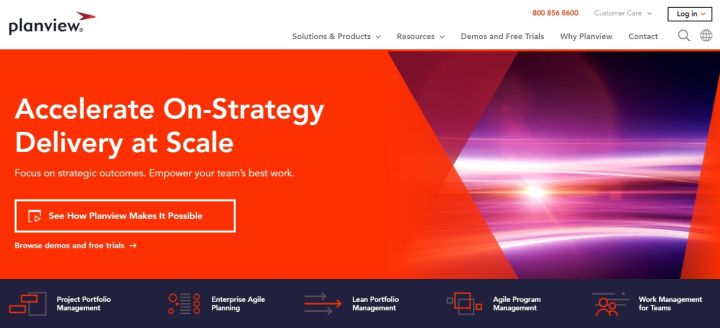
Why consider Planview as your EPM tool?
- Create a strategic roadmap for business workflows.
- Integrated Gantt and capacity view for better project scheduling.
- Capacity balancing across projects.
- Comprehensive analytics and reports to make data-driven decisions.
- Manage project portfolio visually for continuous planning and delivery.
Where does Planview fall short?
- Reviewers find the tool unintuitive.
- Needs extensive training and administrative support.
What does Planview cost?
- Planview does not come with a free plan or a free trial.
- You can request a demo to see it in action.
Great for looking at various financial views at different levels from enterprise to program to project and time tracking.
Capterra review
Jira
Atlassian’s Jira is the #1 agile project management tool for software teams. Jira helps you plan, track, and release software projects.
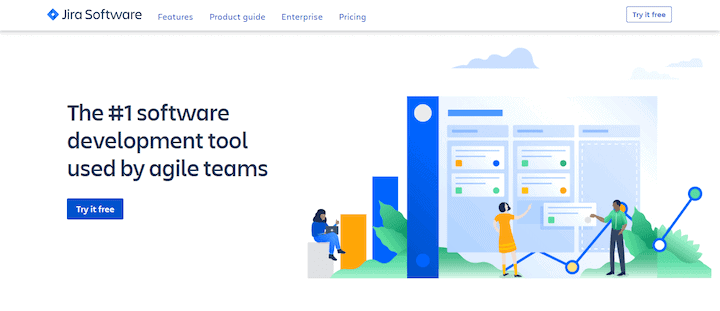
Why should Jira be your go-to EPM tool?
- Create user stories, capture bugs, and plan software development sprints.
- Capture, prioritize, and track tasks as they get done.
- Improve team performance based on real-time reports and dashboards.
- Create custom workflows.
- Integrate with Confluence, Bitbucket, and Pipelines.
Where does Jira fall short?
- While it can be used in other industries, Jira is primarily a project tool for software development teams.
- Needs training and administration support.
What does Jira cost?
- Jira’s free plan is suitable for teams of up to 10 users and comes with 2GB storage.
- The standard and Premium plans cost $7 and $14 per user per month, respectively. And, come with additional features such as access control, audit logs, and unlimited storage.
- Enterprise pricing is available on request.
We used several bug tracking tools in the past but Jira is by far the best one. What I like most: user-friendly interface, provides a nice user experience, Agile SCRUM/Kanban support out of the box.
Cristian, Senior Software Development Manager
Sciforma
Sciforma is an enterprise-scale portfolio and project management platform. It works with all methodologies, including Waterfall, Agile, or a combination of the two.
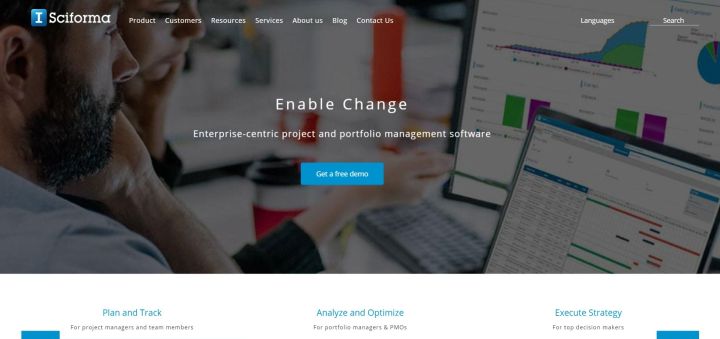
What makes Sciforma the right PM tool for enterprise projects?
- Better understand and anticipate project requirements with demand management.
- Manage project portfolios to translate strategic initiatives into projects and activities.
- Create Work Breakdown Structures to allocate tasks and resources.
- Plan capacities and allocate resources to minimize revenue, customer, and employee losses.
- Track and report time spent on project tasks.
Where does Sciforma fall short?
- Using the tool to its full potential requires training and administrative support.
- Some reviewers find the software slow, clunky, and annoying.
What does Sciforma cost?
- Sciforma does not have a free plan or a free trial.
- You can request a demo to see it in action.
Sciforma is, in my opinion, the best single-platform solution on the market to enable teams to run various methodologies, yet, report holistically at the enterprise level regardless of the methodology used to run each project.
Jennifer, Director of Program Management
LiquidPlanner
LiquidPlanner is a project planning and execution tool. It tries to eliminate planning uncertainties by considering both the best and the worst-case schedule scenarios.
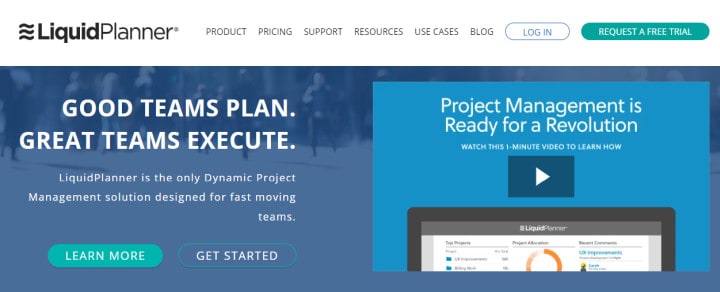
What features does LiquidPlanner come with?
- Automated forecasting and scheduling for better planning.
- Manage portfolio with automated tools to assess the impact of delays across projects.
- Automated resource leveling to reduce the risk of delivery slippages.
- Builtin time tracking and board-based task management.
- Powerful dashboard reports for a high-level overview across projects.
Where does LiquidPlanner fall short?
- Needs onboarding and training support.
- Some reviewers found it hard to manage a 50+ project portfolio.
What does LiquidPlanner cost?
- LiquidPlanner has a free 14-day trial. You can try out all the features in the Professional plan.
- The paid Professional plan costs $45 per user per month.
- Enterprise pricing is available on request. The Enterprise plan comes with workload management and expense reports.
Like any software of this class, It does take some training and experience to get the most out of LiquidPlanner. My best advice is to spend some time to understand how the designers intended the product to be used and use it accordingly.
Chuck, Principal Systems Engineer
Huddle
Compared to other tools on this list, Huddle is different. Huddle helps project teams, clients, and partners collaborate using shared documents.
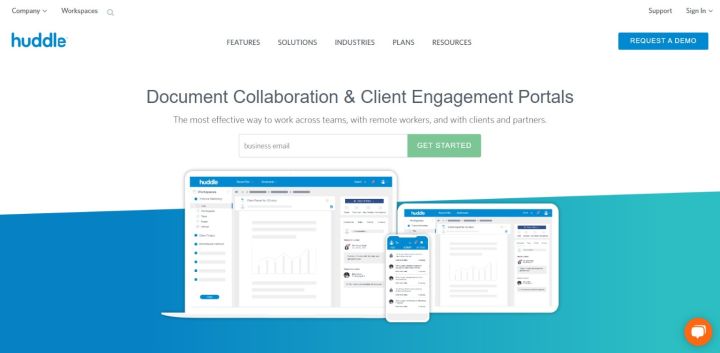
How Huddle helps enterprise project teams?
- Secure file sharing with access control and version management.
- Collaborate on documents with discussion streams and @mentions.
- Work on tasks that are connected with documents and discussions.
- Proofing and approvals.
Why Huddle may not be for you?
If you don’t need document collaboration and version control, Huddle is not for you. Instead, a project management tool with file attachments and comments would serve you better.
What does Huddle cost?
- Huddle does not have a free trial or a free plan.
- You can send a demo request to see Huddle in action.
Huddle’s strength is in its file-management features. In addition, you can add comments to files and notifications, or even request user-specific approvals.
Nari, Support Manager
Workzone
Workzone is a project software that’s powerful yet easy to use. It comes with all the features you’ll need for managing your projects.
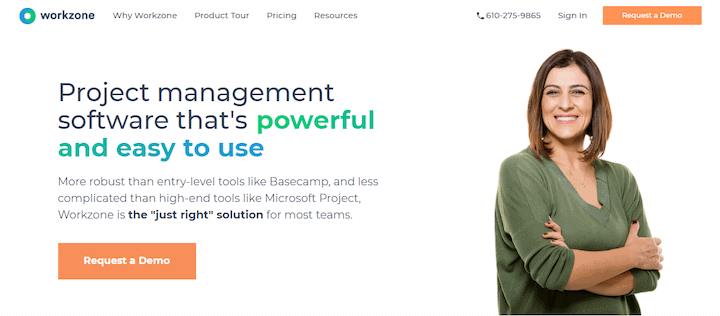
What enterprise PM features does Workzone have?
- Plan project schedules on a Gantt chart or a calendar.
- Manage project tasks using simple task lists.
- Save and reuse project templates to get started quickly.
- Manage workloads across projects.
- Builtin time tracking to keep track of time and expenses.
- Secure file sharing, comments, and approvals.
Where does Workzone fall short?
- You have to pay for the entire year.
- Reviewers complain of its unintuitive UX.
What does Workzone cost?
- Workzone does not have a free plan or a free trial.
- Paid plans range from $288 – $600 per user per year. There’s no option to pay month-by-month.
Using WorkZone has significantly cut down on the number of emails I exchange with our designers. It’s so much easier now to check WorkZone and know the status of projects in the design process.
Courtney, Senior Marketing Manager
Wrike
Wrike is a work management platform for agile enterprise teams. It helps you plan, collaborate, and work on projects across teams in your organization.

What makes Wrike a good EPM solution?
- Custom dashboard to visualize project schedules and deadlines.
- Collaborate on documents with real-time synchronization and approvals.
- Detailed reports to showcase your team’s progress.
- Role-based access, secure sign-on, and private servers.
Where does Wrike fall short?
- Reviewers complain of the confusing user experience.
- Needs onboarding and training support.
- You have to pay for the whole year.
What does Wrike cost?
- Wrike’s free plan is suitable for teams of up to 5 users. It has limited task lists and files sharing features.
- Paid plans range from $118 – $298 per user per year. And come with additional features, including Gantt charts, approvals, and time tracking.
- Enterprise pricing is available on request.
I’m constantly trying to do more in less time! Wrike keeps my projects on-time & on-budget while allowing client collaboration.
Gabriel, Chief Technologist
Entry
Entry comes with project management, resource management, scheduling, and help desk features. It’s available in two variants — cloud-based and on-premise.

Why is Entry perfect for enterprise?
- Built for IT projects.
- Available on-premise for enterprise customers who want to manage their own setup.
- Manage projects with task management and dashboard reports.
- Handle customer support requests with help desk software.
- Plan resource availability and workloads.
Where does Entry fall short?
- Lacks project planning features.
- May not work for non-IT project teams.
What does Entry cost?
- Entry does not have a free trial. But you can request a demo before signing up.
- Cloud-hosted plans range between $20 – $28 per user per month, depending on the number of users.
- On-premise licensing ranges from $18 – $26 per user per month.
And That’s The List Of Enterprise Project Management Tools
Finding the perfect enterprise project management software can be tricky. That’s because all the project teams within your organization should agree upon it.
Hopefully, using the list above, you can shortlist a few tools, try them out, and find a suitable tool for your organization.
Jitesh is an SEO and content specialist. He manages content projects at Toggl and loves sharing actionable tips to deliver projects profitably.

